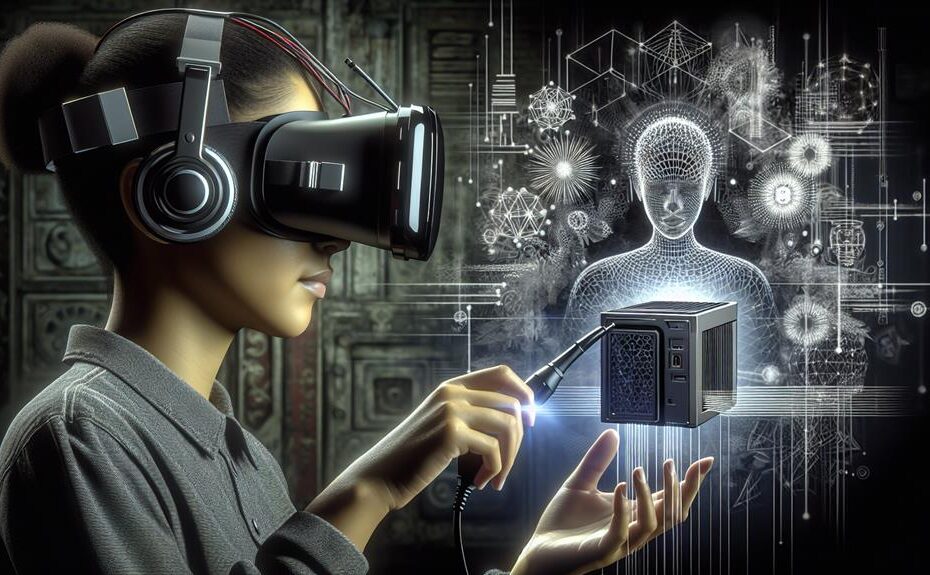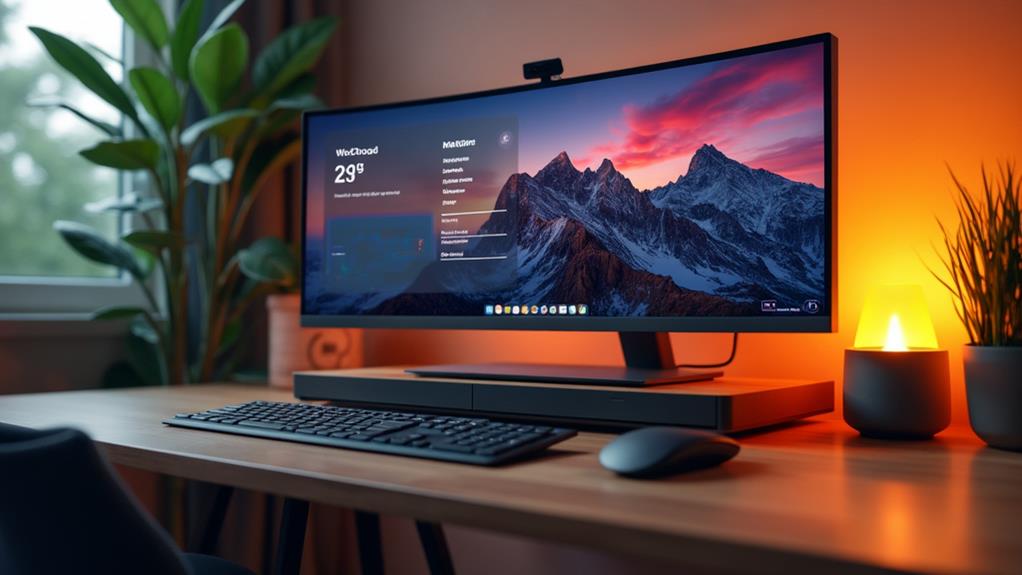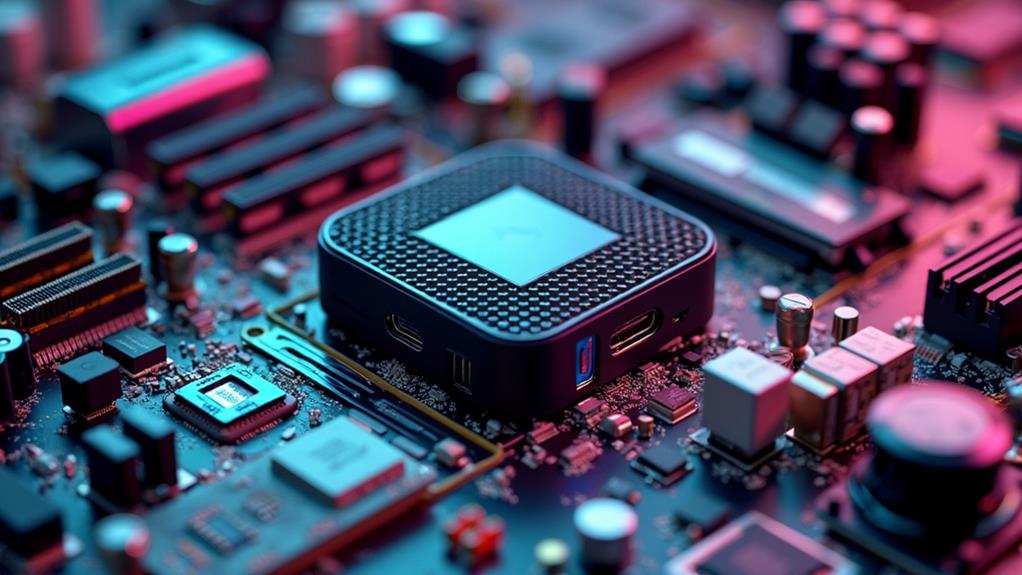



Mini PCs are suitable for Virtual Reality applications. They offer portability, affordability, and energy efficiency. Consider performance metrics, like processing power and graphics capabilities. Mini PCs may have limitations when handling demanding VR tasks due to hardware constraints. Make sure at least 8GB RAM for smooth VR experiences. Compatibility with VR headsets is vital for peak performance. Ports like USB, HDMI, and audio jacks are necessary for seamless integration. Optimize performance by managing heat and preventing bottlenecks. Learn more about Mini PCs' potential for VR applications by exploring GPU/CPU capabilities, RAM/storage needs, and future trends for enhanced VR experiences.
Key Takeaways
- Mini PCs can be used for VR applications due to their portability and affordability.
- Consider hardware limitations for processing power and graphics capabilities.
- Ensure compatibility with VR headsets and necessary ports for optimal performance.
- Optimize performance with sufficient RAM, storage, and connectivity options.
- Monitor for potential bottlenecks and implement effective cooling strategies for consistent VR performance.
Mini PCS Vs. VR Requirements
When considering Mini PCs for Virtual Reality applications, it is important to understand how these compact systems measure up against the demanding requirements of VR technology. In terms of size comparison, Mini PCs are notably smaller and more portable compared to traditional desktop PCs, offering greater flexibility in setting up VR experiences in limited spaces. This portability translates into mobility benefits, allowing users to easily transport their VR setup to different locations.
Price comparison is another vital factor. Mini PCs tend to be more affordable than high-end gaming desktops, making them a cost-effective option for those looking to experience VR without breaking the bank. However, this affordability often comes at the expense of performance, so it's important to strike a balance between price and capability.
When it comes to power consumption, Mini PCs are generally more energy-efficient than larger desktops, which can be advantageous for users looking to reduce their electricity bills or lessen their environmental impact. Despite their smaller size and lower power draw, some Mini PCs can still deliver impressive performance for VR applications.
Performance Metrics to Consider
Considering the performance metrics essential for evaluating Mini PCs for Virtual Reality applications, it is important to focus on key factors that directly impact the user experience. When evaluating Mini PCs for VR, benchmarking methods play an important role. These methods help in understanding the capabilities of the hardware and its ability to handle VR applications effectively. Hardware limitations, such as processing power and graphics capabilities, need to be carefully examined to guarantee a smooth VR experience.
User experience is paramount in VR applications, and Mini PCs must meet certain standards to provide an immersive environment. Latency issues can have a major impact on the VR experience, causing discomfort and reducing the overall quality of interaction. Hence, it is essential to take into account the latency levels supported by Mini PCs to avoid any disruptions during VR sessions.
GPU and CPU Capabilities
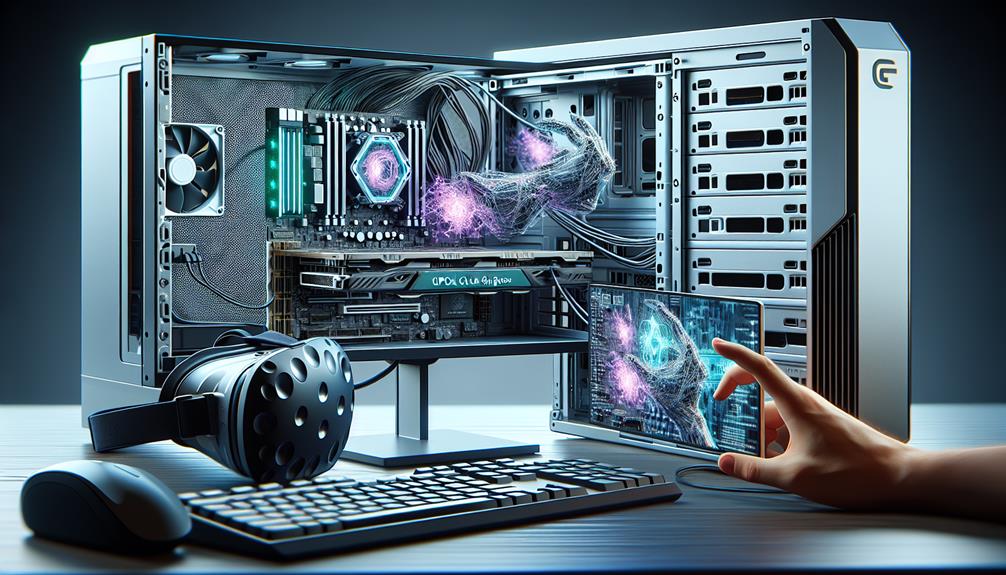
Evaluating Mini PCs for Virtual Reality applications necessitates a thorough evaluation of their GPU and CPU capabilities to guarantee prime performance. When considering GPU and CPU capabilities, it is vital to understand the hardware limitations of mini PCs. While these compact systems offer convenience, their smaller form factor often means limited processing power compared to traditional desktop setups. To guarantee a smooth VR experience, it's important to balance processing power with graphical fidelity. Mini PCs may struggle with demanding VR applications that require high graphical settings due to their hardware constraints. However, software optimization can play a significant role in maximizing the performance of mini PCs for VR applications. Developers can tailor software to work efficiently within the confines of mini PC hardware, optimizing both GPU and CPU usage for better overall performance. By understanding the processing power limitations and focusing on software optimization, mini PCs can still offer a satisfactory VR experience within their capabilities.
RAM and Storage Needs
To optimize the performance of Mini PCs for Virtual Reality applications, it is essential to carefully assess their RAM and storage needs. When evaluating RAM, most VR applications recommend a minimum of 8GB for a smooth experience. However, to future-proof your Mini PC and guarantee seamless multitasking, opting for 16GB or even 32GB is advisable. VR experiences often require significant memory resources to handle complex graphics and interactions without lag. Additionally, storage plays a critical role in storing VR games, applications, and media. A solid-state drive (SSD) is preferable over a hard disk drive (HDD) due to faster loading times and improved overall system responsiveness. When it comes to storage capacity, 500GB to 1TB should be sufficient for most users, but individuals with extensive VR libraries may opt for larger capacities. Keep in mind that Mini PCs often have limited upgrade options for RAM and storage, so it's important to consider these factors upfront while balancing them against budget considerations.
Compatibility With VR Headsets
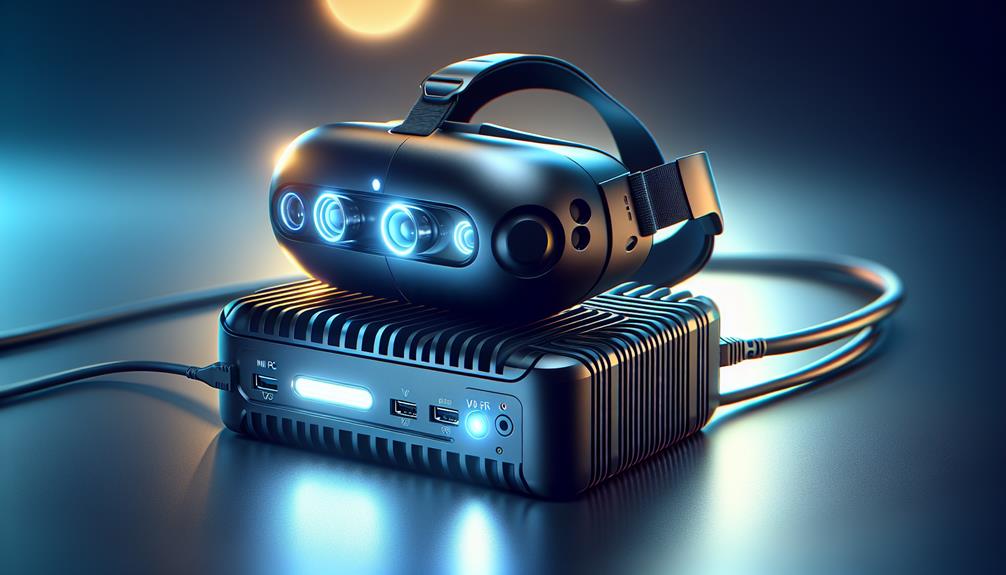
For peak performance in Virtual Reality applications, ensuring compatibility with VR headsets is vital. When considering using a mini PC for VR experiences, one of the critical factors to examine is its VR headset compatibility. Many VR headsets have specific requirements regarding processing power, graphics capabilities, and connectivity that a mini PC must meet to provide a smooth and immersive experience.
Mini PCs, due to their smaller form factor and limited hardware specifications, may face limitations when it comes to powering high-end VR headsets. Some VR applications demand significant processing power and graphics performance, which can strain the capabilities of a typical mini PC. Compatibility issues may arise if the mini PC lacks the necessary ports, such as DisplayPort or HDMI, or if it cannot deliver the required frame rates and resolutions for the VR headset to function at its best.
Before diving into VR experiences with a mini PC, it's essential to verify that the device meets the VR headset compatibility requirements to avoid potential performance issues and ensure a seamless virtual reality experience.
Connectivity and Ports
When examining mini PCs for Virtual Reality applications, evaluating the connectivity and available ports is essential to ensuring seamless integration with VR headsets. The connectivity options and port availability play an important role in the overall performance and usability of the mini PC in a VR setup.
Mini PCs designed for Virtual Reality applications typically come equipped with a variety of connectivity options to support the demanding requirements of VR headsets. These can include USB ports, HDMI or DisplayPort outputs, audio jacks, and sometimes even Thunderbolt connections. Ensuring that the mini PC has the necessary ports to connect with your VR headset is crucial for a smooth and immersive experience.
Additionally, the availability of ports on a mini PC can determine the ease of setting up peripherals such as motion controllers, external sensors, or additional displays alongside the VR headset. Having multiple ports allows for greater flexibility in expanding your VR setup without the need for additional adapters or hubs. Thus, when choosing a mini PC for Virtual Reality applications, carefully considering the connectivity options and port availability is essential to maximize the functionality and compatibility of your VR system.
Cooling and Heat Management
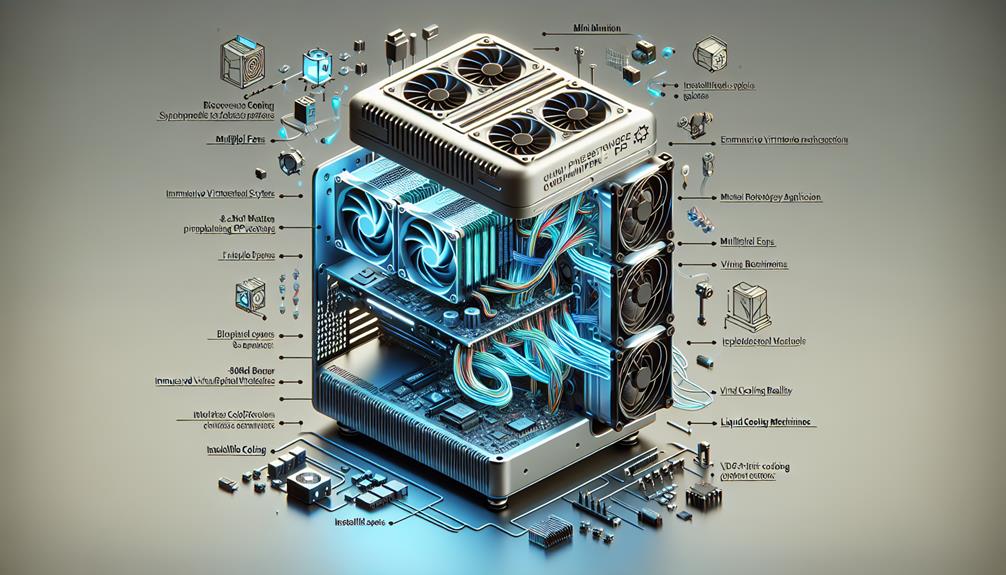
Effective cooling and heat management are critical factors to take into account when evaluating the performance and longevity of mini PCs used for Virtual Reality applications. Mini PCs, due to their compact size, often face challenges in maintaining ideal temperatures during intensive VR tasks. To guarantee smooth operation and prevent components from overheating, it is essential to focus on cooling efficiency and thermal throttling prevention.
Cooling efficiency plays a vital role in dissipating heat generated by the mini PC's components. Proper airflow design, efficient heat sinks, and possibly additional cooling solutions like fans or liquid cooling systems can help in managing temperatures effectively. By maintaining lower operating temperatures, the mini PC can operate at its peak performance without encountering thermal issues.
Moreover, thermal throttling prevention is crucial to avoid performance degradation under high temperatures. Throttling occurs when the system reduces performance to prevent overheating, impacting the VR experience. By implementing effective cooling strategies and monitoring temperature levels, you can minimize the risk of thermal throttling and ensure a consistent and reliable VR performance from your mini PC.
Potential Bottlenecks to Watch
Maintaining peak performance in mini PCs for Virtual Reality applications involves closely monitoring potential bottlenecks that could impede smooth operation and impact the overall user experience. Two critical aspects to watch out for are hardware limitations and processing power concerning the VR experience. Mini PCs, due to their compact size, may have constraints regarding processing power and graphics capabilities, which can affect the quality of the VR environment rendered. Ensuring that the mini PC can handle the demanding tasks of VR applications without compromising on performance is essential to provide users with a seamless experience.
Moreover, latency issues can arise when the mini PC struggles to process data quickly enough, leading to delays in the VR environment's responsiveness. This delay can break the immersive experience and cause discomfort to the user. By addressing potential bottlenecks such as hardware limitations and processing power, mini PC users can enjoy a smoother and more enjoyable VR experience.
Future Trends and Improvements
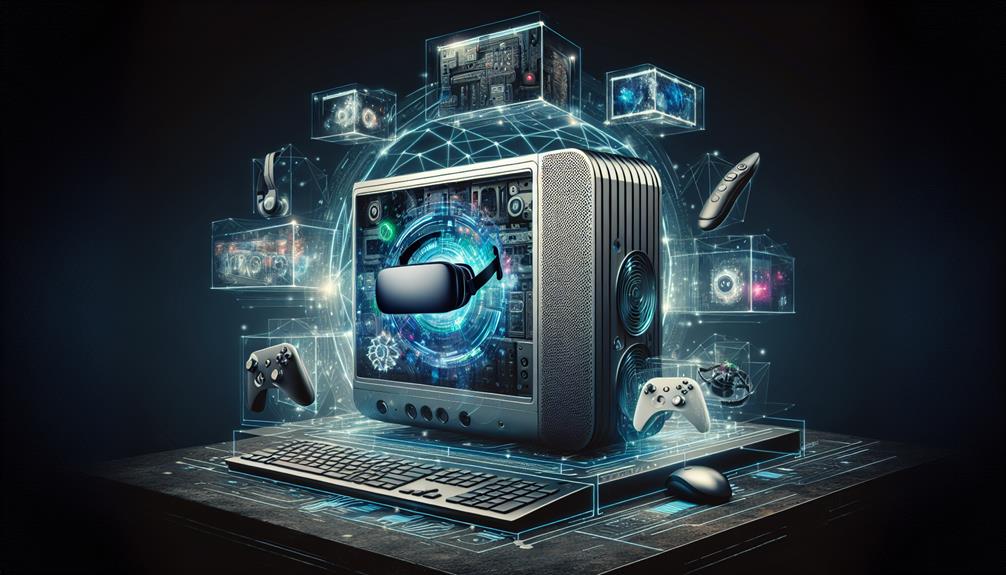
To enhance the performance of mini PCs for Virtual Reality applications, upcoming developments and advancements in technology are essential to consider. Hardware advancements play a vital role in improving the capabilities of mini PCs for VR. As processors become more powerful and efficient, mini PCs will be better equipped to handle the demands of virtual reality environments, providing users with smoother experiences. Additionally, advancements in graphics processing units (GPUs) will allow mini PCs to render high-quality visuals in VR applications, enhancing the overall user experience.
On the software front, innovations will also play a significant role in shaping the future of mini PCs for VR. Optimized VR software and applications will make sure that mini PCs can run VR experiences seamlessly, further improving user satisfaction. These software innovations will also contribute to expanding the market for mini PCs in VR, attracting more users and driving growth in the industry. To sum up, the future of mini PCs for Virtual Reality applications looks promising, with hardware advancements and software innovations set to enhance user experiences and drive market growth.
Disclosure: As an Amazon Associate, I earn from qualifying purchases.
